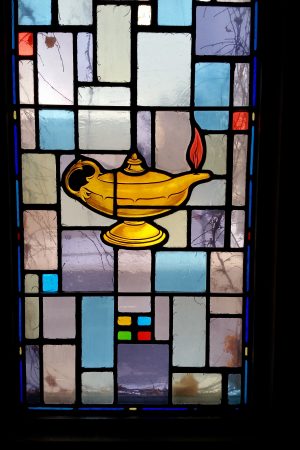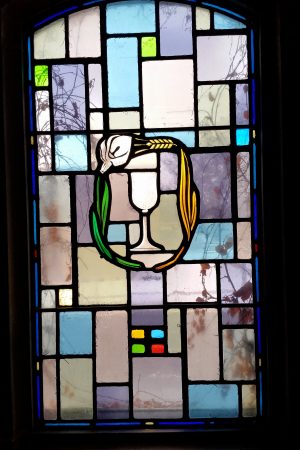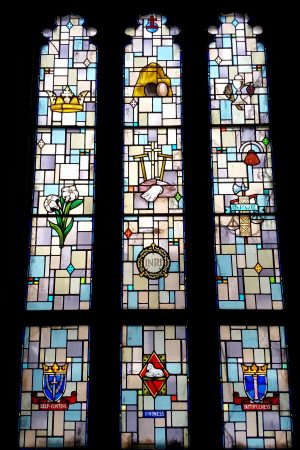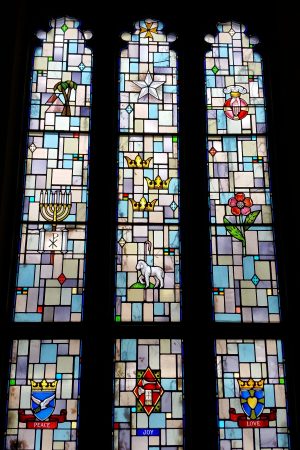First Christian Church dedicated its sanctuary on April 19, 1959. Stained glass windows by the Judson Studios of Los Angeles, California were installed later that year. Overall, the windows tell the story of the life of Christ through traditional symbols. In each window, the symbols are placed on a random background and incorporate translucent antique glass made in Europe and the United States. Blending textures, colors, light-diffusing qualities, and imperfections in this type of glass produces a lively effect. The character of the windows changes with the sun, sky, and seasons.
The Judson Studios
In 1897, The Judson Studios was established in Los Angeles by three Judson brothers and their father, William Lees Judson, a noted California artist. The Studio’s emphasis from the beginning has been on a combination of tradition and innovation. The Judson Studios was started in Mott Alley just off the old Plaza, Los Angeles, by three Judson brothers: Walter H., J. Lionel, and Paul. The three of them came to Los Angeles in 1895 at the behest of their father William Lees Judson who saw the need for a local stained glass shop. William Lees had apprenticed all three in Toronto, Canada. The brothers began with the name “Colonial Art Glass Company” when they left Rafael Glass to go on their own in 1897. William Lees even did some of their art work at this time. After Paul left, the business became the W.H. Judson Art Glass Company, and finally incorporated in 1931 as The Judson Studios. William Lees Judson retired as Dean of the School of Fine Arts in 1920 and the art school moved to the central campus of the University of Southern California. Walter and Lionel purchased the building from their father and moved up to Highland Park on the Arroyo Seco from downtown. In the early days, work was balanced between religious and secular, between recreating the Gothic effect and working for Frank Lloyd Wright in glass and tile on the Ennis and Barnsdall Houses. By the early ’50’s the business was controlled by Horace T. Judson, son of Walter H., and his cousin William Rundstrom. In the ’60’s Horace became sole owner and by 1981 he had sold it to his younger son and daughter-in-law, Karen A. and Walter W. Judson. Judson Studios is still family run, and is currently owned by Karen Judson, her husband Walter Judson having passed away suddenly in January of 2003, and directed by David Judson, fourth and fifth generation respectively. Today the current generation brings a 21st century aesthetic and technological sensibility to the craft, with over 100 years of tradition.

The Lamp
Here the drawing of the oldest type of lamp known reminds us of the light of life. The lamp is a symbol of intelligence, learning, wisdom and knowledge. The gospel of John states “in Him (Jesus) was life and the life was the light of men.” Psalm 119 gives us the familiar phrase: “Thy word is a lamp unto my feet and a light unto my path.”

Chalice, Wheat, and Lily
The chalice is the symbol of the cup Jesus blessed and shared at the Last Supper. The wheat is the symbol of the bread Jesus broke and shared. Together they represent the living memorial of communion. The lily is the symbol of purity and humility. The window presents the common things of life that were transformed by the life of Jesus into symbols of life abundant and eternal.

The Easter Lily and Crown
The Easter lily’s beautiful trumpet-shaped white flowers symbolize purity, virtue, innocence, hope and life—the spiritual essence of Easter. The crown here is a crown of glory representing Christ as King of Kings and Lord of Lords.
Crown of Thorns, Three Crosses, Tomb
The crown of thorns represents the humiliating crowning of Jesus before his crucifixion. INRI: These represent the four initial letters of the Latin words, “Jesus Nazarenus Rex Judaeorum,” meaning “Jesus of Nazareth, King of the Jews.” According to the gospel of John, this title was placed on the cross. The three crosses symbolize the crucifixion as described in the gospel of Luke. Below the central cross is the robe of Jesus for which the Roman soldiers cast lots. The open tomb represents the death and burial of Christ. It also foreshadows the hope of resurrection.
Oikoumene and Ship
This is the Greek world for world, also spelled ecumene. A specifically Christian understanding of the ecumene leads to the use of the word ecumenical, referring to the entirety of the Christian world. The ship represents the church.

Pyramids, Palms, the Menorah
The pyramids and palm trees symbolize Egypt and the flight of Joseph, Mary, and Jesus to escape the wrath of King Herod, who had ordered the killing of all boys less than two years of age. The seven-light menorah is the symbol for the seven lamps of the tabernacle as described in the book of Exodus. With the torah scroll, this is symbolic of the visit to the Temple when Jesus was twelve. Jesus amazed the high priests with his knowledge of the law and commandments.
The Star, Three Crowns, and the Lamb
The gospel of Matthew tells that wise men come from the east to find the newborn King of the Jews. A star appeared and went before them to show the way. The three crowns represent the wise men or kings that came from afar to worship the infant Jesus. In Luke’s gospel, we hear about the shepherds with their flocks in the fields around Bethlehem and the great news of the birth told to them by the angels. Here we see the lamb and staff of the shepherd.
The Hand of God and Rose
Creation is the work of God’s hand. An early symbol to indicate God was a hand extending down from a cloud. The rose is symbolic of the mother of Jesus and the Nativity. It is also symbolic of the messianic hope of the people of Israel. The rose foretells the coming of the Messiah.

Birds, Flaming Wheel with IHS, Tablets
In the earliest days of Christian art, birds were used as symbols of the “winged soul.” The representation of the soul by a bird goes back to the art of ancient Egypt. Here, the birds represent those souls who heard, believed, and followed Jesus. Rotating force is the symbol of divine power. IHS: These letters are the first three letters of Ihsus, the name of Jesus in Greek. This flaming wheel with the IHS represents the divine power of God in Christ. The tablets represent the law and prophets. Jesus fulfilled the law and the prophets.
Wheat and Tares, Fishes and Loaves, the Lamb
The wheat and tares are used to symbolize the parable Jesus told to permit the unrighteous to have fellowship with the righteous. The Sermon on the Mount is represented by the fish and loaves of bread which were used to feed the multitude. The lamb with banner and seven seals is the symbol for Jesus, the victorious Lamb of God.
The Dove and Mountain with Chi Rho
The descending dove and water represent the Holy Spirit and the baptism of Jesus. The scriptures tell us that following his baptism, Jesus went out into the wilderness to fast and pray for forty days and nights. The mountain is symbolic of the wilderness and the temptations from Satan. XP: the Greek letters Chi and Rho are the first two letters of the Greek word for Christ.

The Great West Window
In the central lancet, Christ is portrayed as the Good Shepherd with the words, “Feed My Lambs.” Around the figure of the Good Shepherd are symbols representing the four evangelists and the two great Apostles.
Christian tradition has long connected the authors of the four gospels (Matthew, Mark, Luke, John) with the four “living creatures” that surround God’s throne, as described in Revelation 4:7.
Matthew – The winged man with a book
Mark – The winged lion
Luke – The ox
John – The eagle
The Apostle Peter is represented by the keys and inverted cross. Jesus called Peter the rock on which he would build his church and symbolically gave Peter the keys of heaven and earth. Tradition has it that Peter was crucified upside down as he felt unworthy to be crucified in the same manner as Jesus.
The Apostle Paul is represented by the open bible and sword with the inscription, Spiritus Gladius meaning “Sword of the Spirit.”
Near the symbols for Matthew and Mark are Alpha and Omega – the first and last letters of the Greek alphabet – which refer to Revelation 22:13, “I am the Alpha and Omega, the first and the last, the beginning and the end.”
